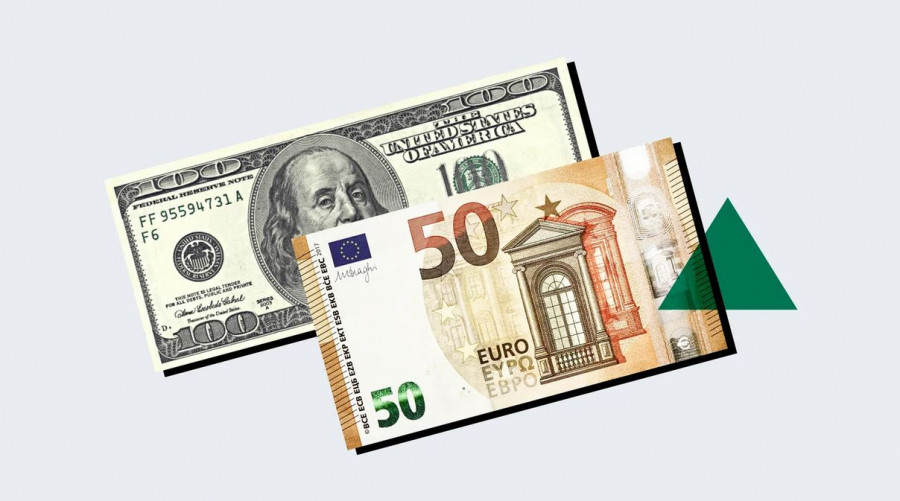See also


 31.03.2025 06:28 AM
31.03.2025 06:28 AMThe first week of every month is the most informative for EUR/USD traders. The economic calendar traditionally includes a report on inflation growth in the eurozone, American ISM indices, and key data on the US labor market. April is no exception, meaning the upcoming week promises to be interesting and volatile.
Important macroeconomic indicators will be published in China during the Asian session on Monday, which may trigger volatility in the EUR/USD pair if they significantly deviate from forecasts. The Chinese manufacturing PMI is expected to remain in expansion territory, rising from 50.2 in February to 50.4 in March. If contrary to expectations, the figure drops below 50.0, risk-off sentiment will increase, potentially benefiting the safe-haven U.S. dollar. The non-manufacturing PMI is also expected to remain in expansion territory at 50.5, up slightly from 50.4.
During the European session, key inflation data from Germany will be released. The overall Consumer Price Index (CPI) is expected to slow slightly in March: after coming in at 2.3% y/y for the past two months, it is projected to dip to 2.1%. The Harmonized Index of Consumer Prices (HICP) declined from 2.8% to 2.6% in February and is expected to fall further to 2.5% in March. Since German inflation data often correlates with broader Eurozone trends (Eurozone CPI will be released the next day), the euro will likely react in line with whether the data beats or misses expectations.
Tuesday's key events include the Eurozone CPI report and the U.S. ISM Manufacturing Index. Most experts forecast that inflation in the Eurozone will slow further in March. The headline CPI rose from October through January, reaching 2.5%, before easing to 2.3% in February. It's expected to edge closer to the European Central Bank's target in March at 2.2%. The core CPI is also forecast to drop to 2.5%—its lowest since February 2022.
Last week, ECB Governing Council member Piero Cipollone stated that many of his colleagues "see increasing arguments for lowering interest rates." He cited falling energy prices, rising real interest rates, euro appreciation, and the risk of a trade war with the U.S. If inflation slows in March, this could further support the case for monetary easing at the ECB's April meeting. Conversely, an unexpected acceleration in inflation would boost the euro.
During the U.S. session on Tuesday, we'll see the March ISM Manufacturing Index. A decline is expected. Most analysts predict it will fall below the 50.0 threshold to 49.6 after spending two months above the expansion/contraction line. Such a result would put significant pressure on the dollar amid growing concerns about a U.S. economic slowdown.
Wednesday's economic calendar is relatively light for EUR/USD traders. The ADP employment report will be the main focus as an early indicator for the official jobs report. According to forecasts, U.S. nonfarm private payrolls will rise by only 118,000—another weak result that doesn't bode well for Friday's Nonfarm Payrolls, even if the correlation isn't perfect.
Federal Reserve Governor Adriana Kugler is also scheduled to speak on Wednesday. Last week, she noted that progress toward the inflation target has slowed since last summer, and recent data showed "some signs of weakness." If she again highlights downside risks to the U.S. economy, the dollar could come under pressure.
Final March PMI data for France, Germany, and the Eurozone will be published. The consensus is that the final numbers will match preliminary estimates. The release will only impact EUR/USD if there are significant revisions.
The U.S. will publish the ISM Services Index, which is expected to remain in expansion territory but dip from 53.5 to 53.0. For dollar bulls, the index must stay above 50.0, especially considering the anticipated decline in the manufacturing ISM.
Key Fed speakers on Thursday include Vice Chair Philip Jefferson and Governor Lisa Cook.
On Friday, all eyes will be on the U.S. labor market report for March. Preliminary forecasts are not favorable for the dollar. Nonfarm Payrolls are expected to rise by only 139,000, following a weak 150,000 increase in February. The unemployment rate is projected to remain unchanged at 4.1%. However, average hourly earnings are expected to slow to 3.9%, down from 4.0%. The labor force participation rate is also forecast to decline to 62.2%—its lowest since December 2022.
If the March jobs report merely meets expectations (let alone misses), the dollar could come under renewed pressure amid growing recession fears and ahead of the next round of tariff escalation.
The first week of April promises to be eventful and volatile. Key macroeconomic reports may trigger intense price swings, and based on preliminary forecasts, these swings are unlikely to favor the dollar.
In addition, on April 2–3, the U.S. is expected to implement new "reciprocal" and "automobile" tariffs. The keyword here is "expected," as Donald Trump could postpone or soften the announced measures at the last minute. If that happens, the dollar will receive strong support. But if the tariffs are implemented as planned, markets will again focus on the negative consequences of trade tensions—even for the U.S. economy. In that case, the dollar could once again fall out of favor.
From a technical standpoint, in the H4 timeframe, EUR/USD trades at the upper line of the Bollinger Bands and above the Tenkan-sen and Kijun-sen lines, but still below the Kumo cloud. It is reasonable to consider long positions only after the pair breaks and consolidates above the resistance level at 1.0840 (Tenkan-sen on D1). The first (and currently only) upside target is 1.0910—the upper Bollinger Band line on D1. In my view, short positions are inherently risky (sellers failed to hold the pair within the 1.07 zone last week), but the 1.0730 mark (lower Bollinger Band on H4) is a key indicator for downside potential.
You have already liked this post today
*The market analysis posted here is meant to increase your awareness, but not to give instructions to make a trade.
Markets continue to act blindly amid the chaotic actions of Donald Trump, who is trying to pull the U.S. out of a deep, all-encompassing crisis like Baron Munchausen pulling himself
Very few macroeconomic reports are scheduled for Friday. Only two are noteworthy: the final estimate of Germany's Q1 GDP and April's UK retail sales data. The German GDP report
 Our new app for your convenient and fast verification
Our new app for your convenient and fast verification
Training video

Your IP address shows that you are currently located in the USA. If you are a resident of the United States, you are prohibited from using the services of InstaFintech Group including online trading, online transfers, deposit/withdrawal of funds, etc.
If you think you are seeing this message by mistake and your location is not the US, kindly proceed to the website. Otherwise, you must leave the website in order to comply with government restrictions.
Why does your IP address show your location as the USA?
Please confirm whether you are a US resident or not by clicking the relevant button below. If you choose the wrong option, being a US resident, you will not be able to open an account with InstaTrade anyway.
We are sorry for any inconvenience caused by this message.

